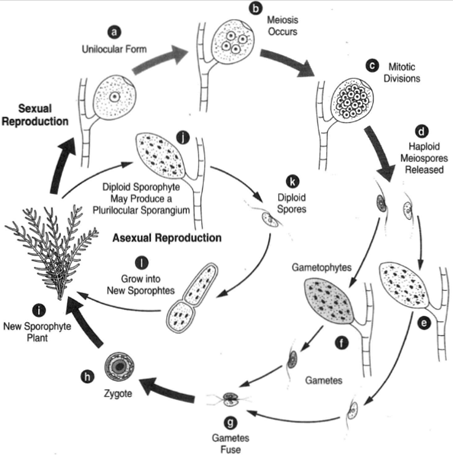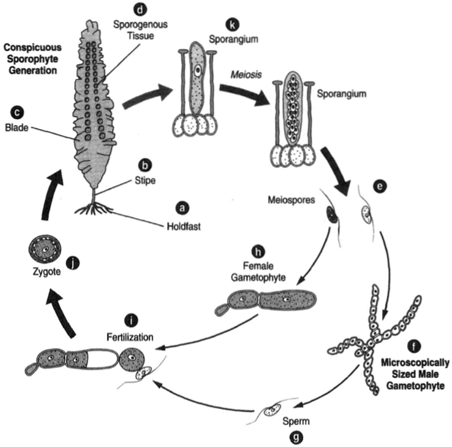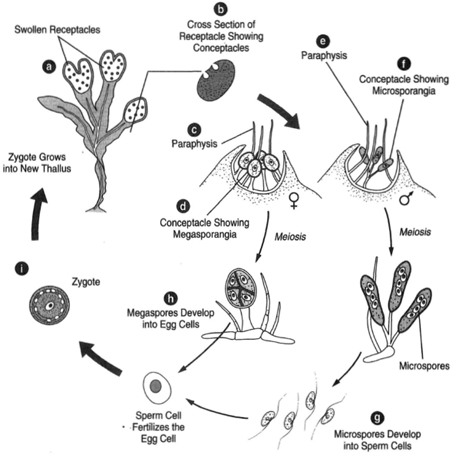Reproduction in Brown Algae
Asexual reproduction is accomplished by either fragmentation or spores. When cells divide, centrioles are apparent in the mitotic figure. This is significant because it is not ordinarily seen in plant cells. Sexual reproduction is of three types: isogamous, anisogamous, and oogamous. Three examples of life cycles are considered followingEctocarpus
We will use Ectocurpus to represent the isogamous form of sexual reproduction in brown algae. The center circle of figure 14-2 shows asexual reproduction while sexual reproduction is shown in the larger circle. Although the sporophyte is 2N and the gametophyte is N, the two generations look alike. Two types of sporangia are produced on the sporophyte: unilocular sporangia (having one compartment) and plurilocular sporangia (having many compartments). The unilocular sporangia each at first contain a single cell. This cell goes through repeated divisions, the first of which are meiotic and, thus, reduce the chromosome number. These first divisions are followed by a number of mitotic divisions, which generate a number of biflagellated haploid zoospores. The zoospores then grow into gametophytes. The gametophytes, of course, are haploid. Plurilocular gametangia are produced on the gametophytes. Biflagellated isogametes are produced in these gametangia by mitosis. The gametes fuse in pairs, thus producing zygotes that can then grow into new sporophyte plants.
While the preceding is clearly an example of alternation of generations, Ectocurpus can go through a reproductive cycle without alternation of generations. Look again at the sporophyte plants in figure 14-2 and note the plurilocular sporangia. These contain many cells that mature into diploid zoospores, which, instead of growing into gametophytes, become new sporophytes. Because there is no gametophyte generation in this sequence, alternation of generations is bypassed.
Some species of Ectocurpus are monoecious, having both plus and minus gametangia on the same plant. Other species are dioecious, requiring a fusion of gametes from different plants to form zygotes.
 |
| Figure 14-2 Ectocarpus life cycle. At right are sporophyte generations exhibiting two types of sporangia: (c) unilocular and (j) plurilocular. In the unilocular form, (a), meiosis occurs, (b), followed by mitotic divisions, (c). Haploid meiospores (d) are released, producing gametophytes, (e) and (f). Gametes fuse, (g), producinag zygote, (h), which grows intoa new sporophyte plant, (i).T he sporophyte at (i) is diploid and may produce a plurilocular sporangium (j). This sporangium produces diploid spores, (k) , which grow to new sporophytes, (I), thus circumventing alternation of generations. |
Laminaria
The sporophyte generation of Laminaria tends to reach considerable size and is differentiated into a rootlike holdfast, a stipe, and a flat blade. These plants attach with such firmness to rocks that when torn away, portions of the rock often come away also. Because the blade portion is much damaged by buffeting wave action, it is replaced by new growth in the spring. Each year, a zone of dividing (meristematic) cells where the stipe and the blade meet renew the blade. While the blade is annual, the stipe is perennial. When the plant is mature enough to produce sporangia, dark patches called sori appear on the surface of the blade. Sori are collections of sporangia. Meiosis takes place in the production of zoospores. These zoospores are minute, bitlagellated cellso f two types: those that produce male gametophytes and those that produce female gametophytes. One-half of the zoospores are of the one type, one-half are of the other.
The microscopically sized gametophytes actually evaded detection until 1916. Each gametophyte is composed of only a few cells. The antheridia that are borne on the male gametophytes each produce a single sperm cell. Likewise, the oogonia of the female plants each house a single egg. Sperm cells swim to the egg cell at the opening of the oogonium. The zygote thus formed grows into the familiar sporophyte plant.
 |
| Figure 14-3 Lakinaria: at left, the conspicuous sporophyte generation consisting of
(a) holdfast, (b) stipe, and (c) blade with (d) sporogenous tissue (k). An enlargement of a
sporangium intermingled with paraphyses. The spores at (e) are meiospores, which grow
into microscopically sized gametophytes. The male gametophyte, (f), and the female gametophyte, (h). One egg cell, (i), is fertilized by the sperm, (g), to produce the zygote, (j), which grows into a new sporophyte. |
Fucus
Fucus exists as a flat, dichotomously branching thallus bearing a shorta nstdi pe growing approximately one foot in length. The ends of certain branches become swollen; these swellings are called receptacles. The receptacles contain spherical chambers called conceptacles, within which sporangia grow. The sporangia are of two types: microsporangia and megasporangia. In Fucus spiralis, both types of sporangia occur in the same conceptacle. In Fucus vesiculosis, the microsporangia and megasporangia are found on different plants. Microspores divide meiotically to form sperm cells, and megaspores produce egg cells by reduction divisions. Although both eggs and sperm are produced, no gametophytes are generated. The spores divide to produce gametes. The gametes are then released into the water, where fertilization occurs. The gametes are the only cells that have the haploid chromosome number. Although both spores and gametes are formed, it is not appropriate to label this alternation of generations.
 |
| Figure 14-4 Fucus. The plant is dichotomously branching with swollen receptacles, (a), having conceptacles, (b). The conceptacles are of two types: microsporangiate with microsporangia, (f), and paraphyses, (e); and megasporangiate with megasporangia, (d), and paraphyses, (c). The microspores develop directly into sperm cells (g), and the megaspores develop directly into egg cells (h). The zygote, (i) grows into a new thallus. Because the spores develop directly into gametes, theisre n o alternation of generations. |




